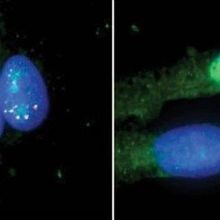Login
SubscribeCas9

Molecular Glue ‘Shreds’ Cas9 and Enables a New Form of CRISPR Control
Ida Emilie Steinmark, PhD | Apr 26, 2023 | 3 min read
In a bid to address safety concerns about immune reactions during treatment with CRISPR-based therapeutics, a new technique speeds up how quickly the body destroys the DNA-cutting enzyme Cas9.

A CRISPR Alternative for Correcting Mutations That Sensitize Cells to DNA Damage
Deanna MacNeil, PhD | Oct 10, 2022 | 3 min read
Researchers turned to base editors to correct mutations causing the rare genetic disease Fanconi anemia without inducing double-strand DNA breaks.

CRISPR Gene Editing: Cas9 and Beyond
Johanna Pruller, PhD and Deanna MacNeil, PhD | 7 min read
Researchers create and improve CRISPR-Cas mediated gene editing technologies based on prokaryotic CRISPR systems and eukaryotic DNA repair mechanisms.

Infographic: Two Guide RNAs Make for Large, Stable Insertions
Dan Robitzski | Jun 13, 2022 | 1 min read
A new technique goes beyond CRISPR and writes two complementary strands of DNA directly into the genome.

With Two RNA Guides, Editing Technique Writes Long DNA Insertions
Dan Robitzski | Jun 13, 2022 | 3 min read
The approach, called GRAND, uses a second guide RNA to write complementary strands of DNA in targeted genomic locations, resulting in efficient insertions that can be hundreds of base pairs long.

Universal Transfection Reagents: Improving Efficiency and Decreasing Cell Toxicity
The Scientist, MilliporeSigma, and Roche | 4 min read
Researchers optimize their transfection protocols with the ideal transfection reagent that has multiple applications, low cytotoxicity, and high transfection efficiency.

Injecting Cockroaches with CRISPR Gene Edits Their Offspring
Sophie Fessl, PhD | May 25, 2022 | 4 min read
A new method has allowed researchers to conduct the first gene knock-out and knock-in edits on cockroaches and may extend to many other insects.

Researchers Uncover New Families of Gene-Editing Enzymes
Annie Melchor | Sep 15, 2021 | 2 min read
The results reveal evolutionary relatives of the Cas9 enzyme now used extensively in biotechnology.

WHO Releases New Recommendations on Human Genome Editing
Annie Melchor | Jul 12, 2021 | 3 min read
The guidance comes after two years of consulting with hundreds of stakeholders, including indigenous peoples, religious leaders, patient groups, and scientists.

Assay for Sickle Cell Anemia Is Repurposed to Diagnose COVID-19
G.B.S.N.P. Varma | Nov 18, 2020 | 5 min read
A CRISPR-based, paper-strip test developed by Indian researchers performs as well as real-time PCR in identifying the presence of SARS-CoV-2 and returns results within an hour.

CRISPR’s Adaptation to Genome Editing Earns Chemistry Nobel
Amanda Heidt | Oct 7, 2020 | 4 min read
Emmanuelle Charpentier and Jennifer Doudna reprogrammed the bacterial immune response into one of the most popular tools for genetics and molecular biology.

Symptoms in ALS Mouse Model Improve with CRISPR Base Editing
Abby Olena, PhD | Apr 10, 2020 | 4 min read
Researchers slowed disease progression in the mice by injecting two different viral vectors, each containing one part of the DNA encoding the Cas9 protein, to edit the causative gene.

New “Prime Editing” Method Makes Only Single-Stranded DNA Cuts
Emma Yasinski | Oct 21, 2019 | 4 min read
In demonstrations in cell lines, the technique has a similar efficacy to CRISPR-Cas9, but fewer off-target effects.

First Successful Gene Drive in Mammals
Abby Olena, PhD | Jan 23, 2019 | 4 min read
Researchers use a CRISPR-Cas9 strategy to expand a desired trait from 50 percent of mouse pups to about 72 percent.

New Technique Limits CRISPR-Cas9 Off-Target Mutations
Abby Olena, PhD | Sep 12, 2018 | 3 min read
A mouse study details a method called VIVO that predicts the accuracy of any guide RNA.

New Methods to Detect CRISPR Off-Target Mutations
Sandeep Ravindran | Mar 1, 2018 | 7 min read
Researchers have developed a variety of techniques to detect when CRISPR misses the mark.

Most Accurate CRISPR Gene Editing Yet
Kerry Grens | Sep 22, 2017 | 2 min read
A tweaked Cas9 nuclease reduces off-target effects to levels below that of previous versions of the enzyme.

CRISPR Corrects RNA-based Disease Defects
Kerry Grens | Aug 10, 2017 | 2 min read
In human cells, researchers deploy the genome editor to snip out toxic repetitive sequences.

Details Published on CRISPR-treated Embryos
Kerry Grens | Aug 2, 2017 | 4 min read
Scientists correct a mutation in fertilized eggs that causes a severe cardiac disease.
